- The endangered Malayan tapir (Tapirus indicus) is the world’s biggest tapir, and the only one found in Asia. It ranges today from the Malaysian Peninsula to Myanmar and Thailand, and the island of Sumatra; it is threatened chiefly by habitat loss and habitat fragmentation, and by hunting, road-kills and bi-catches by snare hunters.
- Though the Malayan tapir has been largely neglected in the past by conservationists and by the Malaysian public, the tide is slowly turning in its favour and interest in conserving the species is growing.
- The Malay Tapir Conservation Project (MTCP), along with other scientific programs, are actively researching tapir behaviors, so as to develop more effective conservation plans.
- The Malaysian government too is working to protect the animal. It has earmarked funds for the animal’s conservation as part of the current ten-year economic development plan. But the key to the Malayan tapir’s survival lies in a stronger commitment to forest habitat protection.
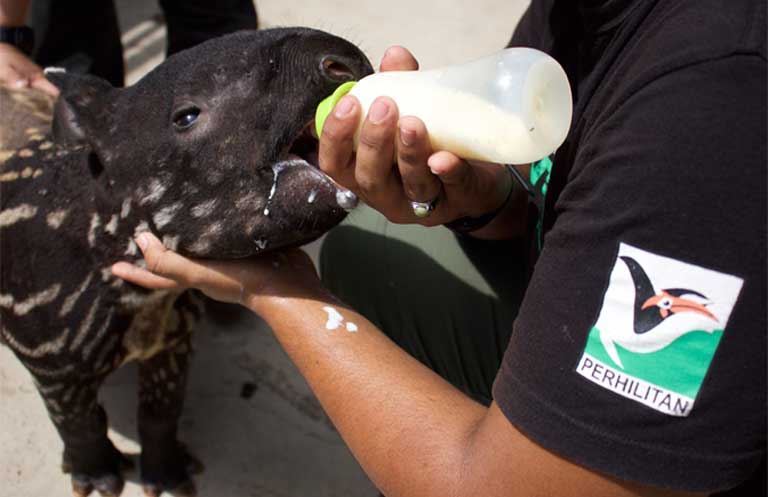
Two-month old Asahan sucks milk greedily from a bottle. The baby Malayan tapir — his spotty brown juvenile coat already morphing to the distinctive black and white of an adult — was rescued by local villagers who found the displaced animal wandering alone through an oil palm plantation and then handed him over to Malaysia’s wildlife department.
Asahan is the newest resident at the Sungai Dusun Wildlife Rescue Center, about 90 minutes north of Malaysia’s capital, Kuala Lumpur, and is nestled within a 5,000 hectare (19.3 square mile) forest reserve that is home to sun bears and flat-headed cats. But this conserved forest patch is hemmed in by oil palm plantations — now the backbone of the Asian nation’s economy.
The facility was initially set up for captive-breeding of the Sumatran rhino — declared extinct in the country last year. So now it has shifted its focus to tapirs as part of the Malay Tapir Conservation Project, an effort largely funded by the Copenhagen Zoo.
The facility is currently home to 11 tapirs. Some will be rehabilitated and released to the wild, others not, including the oldest, a 19-year-old female known as Bendul who is blind.
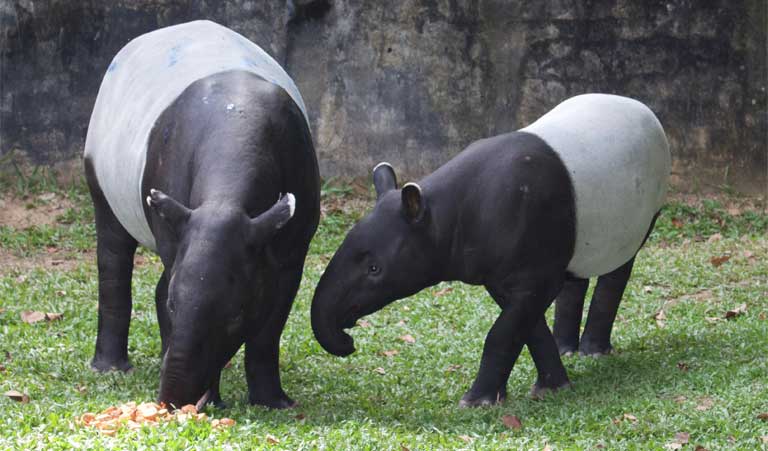
A black and white blank slate
The Malayan tapir (Tapirus indicus) is the largest of the world’s tapirs, and the only one found in Asia. The three others, which are better known, live in Central and South America.
T. indicus today is found on the Malaysian Peninsula, in Myanmar and Thailand, and on the Indonesian island of Sumatra. It is listed as Endangered by the IUCN, due to “loss of available habitat, fragmentation of remaining habitat and increasing loss of individuals due to hunting, road-kills and bi-catches by snare hunters.” Estimates put the total population at fewer than 2,500 mature individuals, mostly isolated within rainforest fragments.
“I realized there was no information on [Asia’s] tapir,” said researcher Carl Traeholt, as he recalled his decision more than a decade ago to launch a project to try and conserve the species. “It was a large mammal that was forgotten, but charismatic and with a colorization that was totally unique.” In 2008, Traeholt officially launched the Malay Tapir Conservation Project (MTCP).
Renowned 19th century British naturalist Alfred Russel Wallace had expressed a fascination for Asia’s only tapir, calling it a “curious” animal, and a “puzzle” of geographical distribution. But few scientists had taken much of an interest in the species since then. So Traeholt, the Program Director of the Copenhagen Zoo’s Southeast Asia Conservation Program, started with an almost blank slate.
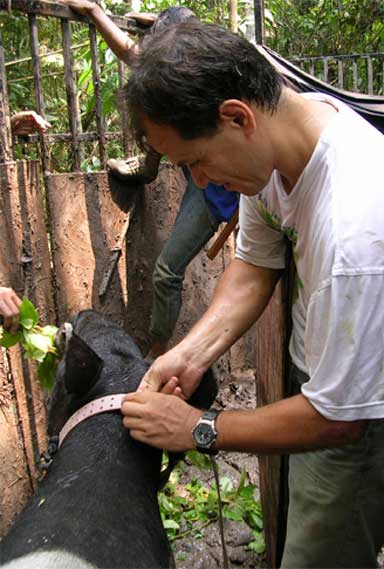
The only field study he and his team had to go on was one from the 1970s; the work of Keith Williams, an Australian scientist who became the founding chairperson of the IUCN SSC (Species Survival Commission) Tapir Specialist Group. Williams had observed the tapirs in Malaysia’s national park and used radio collars to track their movements.
Traeholt and his MTCP team — working closely over the years with Malaysia’s wildlife department, locally known as Perhilitan — wanted to get a clearer sense of the numbers of Malayan tapirs remaining on the peninsula, as well as documenting their preferred foods and behaviors to better guide conservation efforts.
They focused their initial research within the Krau Wildlife Reserve, an expanse of more than 60,000 hectares (231.7 square miles) of forest — much of it untouched — in the heart of the Malaysian peninsula. The researchers set up motion-activated cameras along key trails there, counted animal tracks and captured five tapirs, all of which were fitted with radio collars and monitored for a year or more.
The team’s efforts helped yield positive results: Traeholt expects the first Malayan Tapir Conservation Action Plan to be released by the government this year. It will provide “specific and realistic guideline[s] in managing the species within the ten-year period, 2016-2025,” according to Mahathir Mohamad, the Assistant Director of Perhilitan’s Biodiversity Conservation Division. “It is an ongoing process and the first [strategy] workshop should be held within this year.”
A fascinating, but hard to study animal
The tapir — largely nocturnal, rather shy and difficult to observe in the dense rainforest undergrowth — offers a constant challenge to scientists as they try to gather and analyze data about it. The animal’s coloring is especially problematic.
“They are a heck of a lot more complicated than most animals I’ve worked with,” Traeholt declared. “They are not easy to distinguish from one another. The tip of the ears is totally white, and the rest is black. That makes it very difficult to take pictures, and also for computer [imaging analysis] too.” An early breakthrough came when the researchers established that individual tapirs could be identified by subtle markings on their thick-set necks.

Tapirus indicus habits also present difficulties: “They are nocturnal. How do you trap a tapir in a tropical rainforest at night?” Traeholt asked rhetorically. “You can hear it, but if you turn on the spotlight, and there’s a tapir, it will run away. We have to use a headlamp [to get through the jungle], but once we are close we turn to infrared.”
Despite these challenges, the MTCP has developed a number of studies that have provided benchmarks for the work of scientists elsewhere. For example, the team established that the population within the Krau Wildlife Reserve numbered just 30 to 50 animals — far fewer than initially thought. That finding suggested that the population across the entire peninsula would also be lower. Today, Perhilitan estimates that there are only about 1,500 on the Malay peninsula.
Research by Australian biologist Boyd Simpson, who joined MTCP at a later stage, suggests the tapir eats a stunningly wide variety of plants — 217 species to be precise according to his study, though the IUCN ups that to 380 plant species — which means that the animal could play a significant role in rainforest seed dispersal, though some researchers argue otherwise, since the tapir seems to thoroughly chew up seeds it consumes. The team is presently exploring why Krau tapirs are such regular visitors to the natural salt licks and mineral licks scattered around the reserve.
The research team has also moved beyond Krau, and conducted studies in semi-wild locales including Sungai Dusun, which eventually became a center for captive-breeding. In 2007, the world’s first tapir twins were born in captivity. In the wild, the mother normally gives birth to only one calf, after 13 months, which will stay with her for up to two years.

Tapirs in traffic
One local name for the tapir is the badak tampung (patched rhino), reflective of this large mammal’s distinctive coloring — a black body and contrasting white saddle — and the fact that it is an ungulate, closely related to the rhino and horse.
But the tapir’s short trunk-like nose — used to forage and also as a kind of snorkel when it swims — as well as its unusual feet (four individual hooves for each front foot and three for each back foot), make it one of the world’s more distinctive animals. Its mode of communication is also unexpected: this large earthbound animal, vocalizes with a series of excitable squeals — sometimes sounding rather like a monkey — as well as with clicks.
Like many Asian rainforest species, including more charismatic megafauna like the tiger and orangutan, the Malayan tapir is under pressure from shrinking forests. The IUCN believes the number of tapir across its range has dropped by more than 50 percent in the past 36 years, as the animals’ habitat has been converted to plantations and residential estates.
An adult tapir is hefty — averaging just over a meter (3.6 feet) tall and weighing as much as 350 kilograms (771.6 pounds). Such a big creature is relatively safe in dense forests or wetlands, but deforestation has pushed the animal into closer proximity with people, at its peril.
In the past decade, 63 tapirs were killed in Malayan traffic collisions, according to Perhilitan. The Sungai Dusun Center, meanwhile, has rescued 104 animals; the victims not only of cars and trucks, but also poachers. While scientists say tapirs don’t appear to have any predators and are not prized for their meat or coat, they are sometimes the victims of traps and snares set for other animals sought-after for the illegal wildlife trade.

“Most [tapir] deaths are caused by traffic accidents,” said Mohd Zulfadli Zainor, the Sungai Dusun rescue center’s assistant director. “They are nocturnal, so that’s usually why they get hit, because they are out at night. With their black and white coat, drivers don’t realize the tapir is even there.”
Animals discovered in pit traps or injured in traffic that aren’t too badly hurt, are patched up and released in the area where they were found, while those more badly injured are taken to Sungai Dusun to be nursed back to health, and hopefully returned, at some point, to the forest.
Tracking released animals is crucial if scientists are to determine how they fare in the wild after rehabilitation, but even the satellite collars offer a challenge. “On the ground, we use a [VHS] receiver and search until we find the tapir.” Perhilitan’s Mahathir told Mongabay. “It’s very hard and you can really only detect [the animal] about five meters [16.4 feet] away.”
Raising public awareness
Malaysia has erected warning signs to alert drivers in rural areas where they’re most likely to encounter tapirs. The country also plans to build special wildlife crossings — viaducts that would make roads less dangerous for animals — but conservation groups agree that it is the preservation of habitat that is most crucial to the species’ long-term survival.
That’s especially true due to the tapir’s slow reproductive cycle and long weaning period, which effectively means each female can have only one baby every three years. So quality habitat is needed for the safe rearing of the young.
“Malaysia has done a lot of plans for tigers and other species, even the rhino, but [tapir] habitat is not being taken care of, so the population for sure will drop or disappear,” said I.S. Shanmugaraj, the executive director of the Malaysian Nature Society, the country’s oldest environmental group. “Scientists are still struggling to find out how the tapirs live, but by the time they do, the forest will have disappeared. We must protect their habitat,” he said with urgency.

Public participation will be essential to their preservation. In recent years, the Malaysian public has become more environmentally aware, and is increasingly likely to campaign for endangered species and for protecting threatened habitats. Residents near Kuantan, in the eastern part of the country, for example, recently led a vocal campaign against Lynas, a rare earth mining company, and also against the proliferation of bauxite mining in their district, forcing the government to impose a temporary ban on the industry earlier this year.
When the World Wide Fund for Nature brought its globetrotting “1600 Pandas World Tour” exhibition to Kuala Lumpur in 2014, local ad industry employee Kelvin Low saw it as an unexpected opportunity to draw attention to the plight of tapirs.
WWF’s exhibition, which has moved from Paris and Berlin to Taipai and other major cities, boasts 1600 papier-mâché pandas, symbolic of their remaining number in the wild. Kelvin Low used the occasion to stage what he called a “hijacking”. He placed his custom-made ceramic tapir alongside the show’s pandas and added a handwritten sign: #TAPITAPIR, which translates in Malay as: “But what about the tapir?”

He was quickly shooed away by security, but not before his friends were able to post pictures of the “hijacking” to social media — one small step toward making the Almost Famous tapir, Famous!
Evicted from WWF’s exhibit, but still sitting outside the event with his tapir figurine, Kelvin Low fielded questions from curious Malaysians: “A lot of people asked me, ‘Is that an anteater?’ or ‘Is that an elephant?’,” he told Mongabay. “I was quite shocked seeing the crazy response and how little we, as Malaysians, knew about this animal.”
This guerrilla advertising — plus other more mainstream PR efforts — seems to be paying off. This year, on World Tapir Day in April, the same venue that held the WWF event ran a new exhibition featuring 3,000 Malayan tapirs: all made by Malaysian schoolchildren.
Educating a country, funding conservation
Geetha Annavi, a senior lecturer in the biology department at Universiti Putra Malaysia, has another awareness building plan. She wants to give Malaysian volunteers the chance to work alongside her scientific team during field studies.
Annavi and her six research students are currently investigating tapir behavior, plus the bacteria in their gut (able to digest hundreds of different plant species), and their genetic diversity. Her work is focused largely on semi-wild and captive populations, but she is also undertaking a study to confirm whether tapirs are living in the North Selangor Peat Swamp Forest, a vast wild peatland an hour north of Kuala Lumpur.
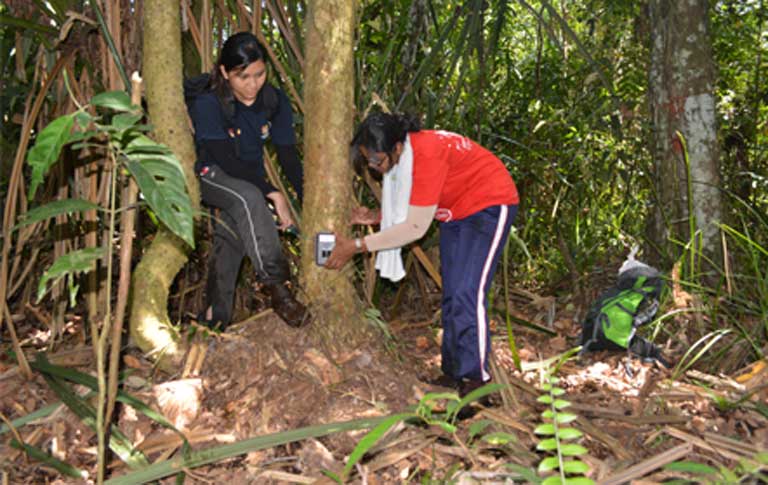
The scientist, who studied the behaviors and family tree of a badger family in the British countryside for her PhD, is applying techniques learned in the UK to her work with tapirs. Like Traeholt, her initial interest sprang from the fact that, even today, there is still so much that remains unknown about the animal.
Beyond her volunteer program, she is also hoping to take her enthusiasm for the tapir into Malaysian classrooms.
“We have to get them young,” Annavi said of the need to get children involved in conservation; a cuddly toy tapir with fluffy white ears sits on her desk beside a pile of files. “[Children] are our future. It’s their responsibility to take care of these animals.”
Since the MTCP began in 2008, the interest in tapirs has slowly but steadily grown, an interest that is now even spreading beyond the animals’ home range. Malaysia instituted an official loan program with Japan last December when two Malayan tapirs were sent to the Nagasaki Biopark where they are expected to stay for a decade. In March, the female of the pair successfully delivered a calf.

And while tapir conservation remains underfunded today, some money has been forthcoming. The Malaysian government has set aside 1.18 million ringgit (US $288,668) for the animal’s conservation as part of the current ten-year Economic Development Plan. Meanwhile, the National Policy on Biological Diversity has set a series of policy targets to protect land, flora and fauna up to 2025.
Saving a species, one tapir at a time
Mohd Zulfadli Zainor confided that funding is one of his key concerns too: food alone to feed animal guests at the Sungai Dusun Wildlife Rescue Center costs about 200,000 ringgit (US $48,927) per year. But he hopes the tapir’s rising public profile, as well as the national action plan, will ensure there is more money for tapir conservation.
Inside the rescue center, the day-to-day work of conserving T. indicus continues, one tapir at time. Veterinarian Dr. Donny Yawah sprays ointment on a tapir that has reacted badly to some sort of biting fly from a nearby chicken farm; he also captures the insects in a test tube for analysis in the lab. The doctor has been working with tapirs since 2012, and suspects one of the females in his care may be pregnant. Further tests are planned.
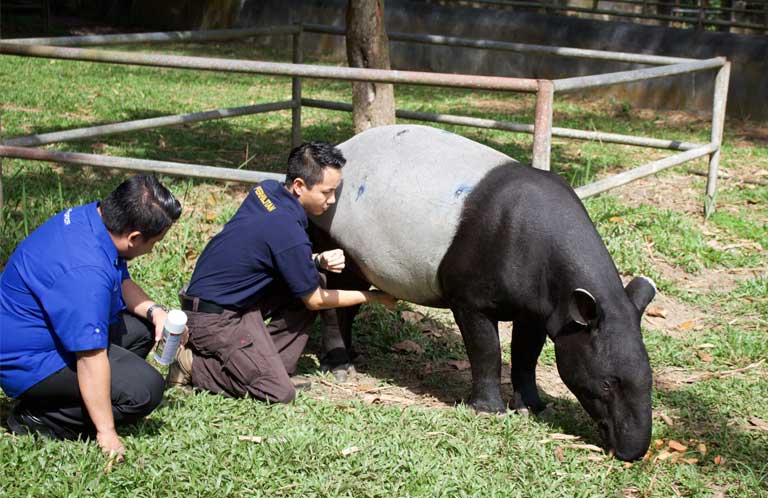
“I feel I have a chemistry with the tapir,” he explained as he made his rounds. “They are very docile compared with an animal like the tiger and I can touch them. It’s easy to understand their feelings and emotions.”
Meanwhile, Asahan is guzzling his way to the bottom of another bottle of milk — he’s a growing tapir, after all, and consumes two liters (2.11 quarts) every day, though is expected to move on to grasses and seeds around the age of six months.
The Malaysian rangers who work with the rescue center hope that once Asahan is bigger, that he, like the other young adults housed there, will be able to return to the wild. But considering Malaysia’s exploding agribusiness development and rapid deforestation, Asahan’s future will ultimately depend on whether there is enough of a wild for him to return to.
Review questions for educators
These questions can help provide a framework for exploring topics presented in this story.
- What is the Malayan tapir?
- Where does the Malayan tapir live?
- Where is the Malayan tapir different from tapirs in the Americas?
- Why is the Malayan tapir endangered?
- How are conservationists working to protect the Malayan tapir?
